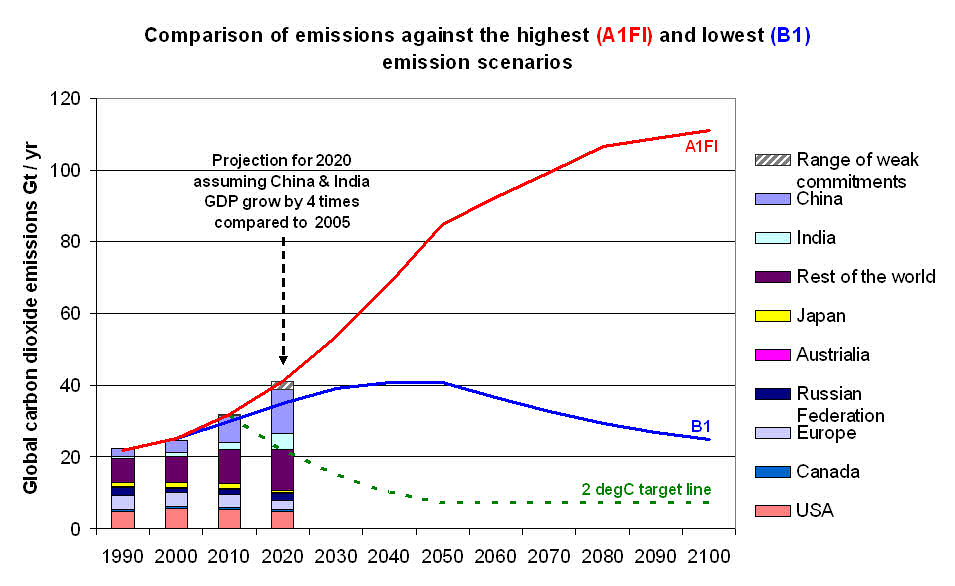Global emissions conclusions
The future of global emissions is still uncertain following the Copenhagen Summit and the Accord that came from it. The pledges that countries have made to reduce emissions don't offer strong guarantees for the future: the rich countries are not offering very impressive cuts; and carbon-intensive economic-growth, of developing nations, could allow emissions to continue along the highest emission scenario line. Talks have just started at Cancun (Mexico), which will hopefully agree stronger targets. It looks like there is little hope of us restricting global mean temperature rise to 2ºC though.
The following graph shows global carbon emissions for each decade from 1990 to 2100. These are compared against the highest (A1FI) and lowest (B1) SRES Emission Scenarios. The column of emissions in 2020 is based on the Copenhagen analysis, in this case assuming China's and India's economies grow by four times compared to their size in 2005.
- At the moment it looks like our only hope of following lower emissions scenarios is for poor economic performance - especially in the developing world. This is not a great position to be in but I do wonder if it might be quite likely. I am thinking about the fact that we are consuming the Earth's resources at an increasingly unsustainable rate. We are likely to run out of things like rare metals (e.g. used in modern electric motors), chemicals required for fertilisers, water, and even fossil fuels! Unless we can unlink economic growth from consumption, it seems likely that we will see some more wobbles in regional and global economic futures...and that is even before considering the economic damage that is likely to result from unchecked climate change and the natural disasters that seem almost inevitable.
- Nothing in the pledges to the Copenhagen Accord suggest that there is any hope of limiting climate change to the stated "2 degree rise in global temperature". Even guaranteeing that we follow low emission scenarios, that might limit temperatures to 3ºC, will need much stronger international agreements. Developed nations need to pledge more ambitious emission reductions, and this will hopefully encourage the developing nations to set targets to grow without becoming so carbon intensive. It is an evolving process though, and the fact that governments are talking about trying to limit temperature rise means that there is still hope.

.jpg)
Return to main Emissions Targets page

![link to W3C validation website, which will show that the stylesheets are Valid CSS [css]](http://jigsaw.w3.org/css-validator/images/vcss-blue)
![link to information about this website [info]](../images/btn_info.jpg)
![jump up to the top of this page [top]](../images/btn_top.jpg)